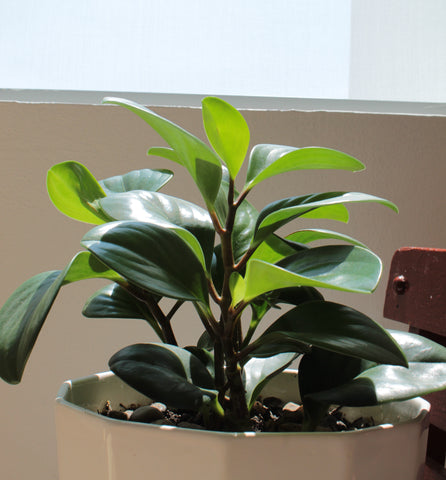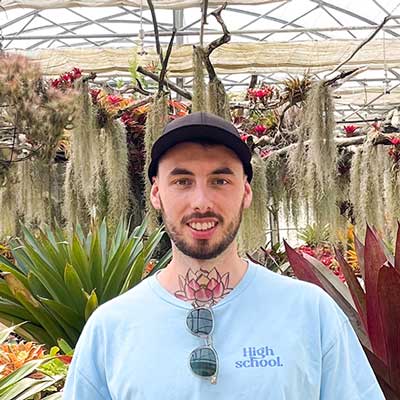Introduction
Peperomia obtusifolia, commonly known as the baby rubber plant, is a small and easy-to-care-for houseplant that belongs to the Piperaceae family and is native to Central and South America.
Baby rubber plant has thick, glossy leaves that are usually a deep, rich green color, although some varieties may have variegated leaves. The leaves are oval-shaped and can grow up to 10cm long. The plant can also produce small, white or yellowish-green flowers on spikes.
One of the reasons baby rubber plants are so popular as indoor plants is that it is low maintenance and can tolerate a variety of growing conditions. It prefers bright, indirect light, but can also grow in low-light conditions. It should be watered only when the soil feels dry to the touch, as overwatering can lead to root rot.
Baby rubber plant can be propagated easily by stem cuttings or leaf cuttings, and it is also a good plant for terrariums or small containers.
Overall, the baby rubber plant is a great choice for a low-maintenance houseplant with attractive foliage.

Light
Peperomia obtusifolia prefers bright, indirect light. It can also tolerate low light conditions, but too much direct sunlight can scorch its leaves.
A good location for this plant would be near a window that gets bright, indirect light for most of the day, or in a room that receives plenty of natural light. If you don't have a good source of natural light, you can also grow it under artificial grow lights, such as fluorescent bulbs.
It's important to note that the amount of light a plant receives can affect its growth and appearance. Too little light can cause the baby rubber plant's leaves to become pale or turn yellow, while too much direct sunlight can cause the leaves to burn or develop brown spots.
If you notice that your baby rubber plant isn't growing or looks unhealthy, it could be a sign that it's not receiving enough light or too much direct sunlight. You can adjust its location accordingly to ensure it's getting the right amount of light.
Do Peperomia obtusifolia need lots of light?
While it can tolerate low light conditions, it will grow and thrive better in a brighter location.
Direct sunlight can scorch its leaves, so it's important to avoid placing it in a spot where it will receive too much direct sunlight. Instead, a location near a window that gets bright, indirect light for most of the day or in a room that receives plenty of natural light is ideal.
If your baby rubber plant isn't getting enough light, it may become leggy or develop smaller leaves. However, too much direct sunlight can cause the leaves to burn or develop brown spots. So, finding the right balance is important for the health and growth of your plant.
Soil
In terms of soil requirements, Peperomia obtusifolia prefers well-draining soil that is rich in organic matter. A good soil mix for this plant should be a combination of potting soil, perlite, and peat moss. This will provide the plant with the right balance of nutrients, aeration, and moisture retention.
It is important to note that Peperomia obtusifolia is sensitive to overwatering and can easily develop root rot if the soil is too wet. Therefore, it is essential to ensure that the soil is well-draining and not kept too moist. Water the plant when the top inch of soil feels dry to the touch.
Water
Peperomia obtusifolia prefers to be kept slightly moist but not waterlogged. Overwatering can lead to root rot and other problems. Therefore, it is essential to allow the soil to dry out slightly between waterings.
The frequency of watering will depend on various factors such as the size of the plant, the size of the pot, the level of humidity in the environment, and the season. As a general rule, water the plant when the top inch of soil feels dry to the touch. A sustee soil moisture meter can tell you exactly when to water your plants.
When watering, use room temperature water and ensure that the soil is thoroughly moistened but not saturated. Allow the excess water to drain away from the pot, and avoid leaving the plant in standing water.
Fertiliser
When it comes to fertilisation, this plant does not require heavy feeding and can thrive with minimal fertilisation.
During the growing season, which typically runs from Spring to Autumn, you can feed your Peperomia obtusifolia once every two to four weeks with a balanced, water-soluble fertiliser. A balanced fertiliser contains equal parts of nitrogen, phosphorus, and potassium (NPK).
You can dilute the fertiliser to half or a quarter of the recommended strength to avoid overfeeding, as this can cause salt buildup and damage to the roots. Apply the fertiliser to the soil around the plant, avoiding the leaves and stems.
During the winter months, when the plant is not actively growing, you can reduce or stop fertilisation altogether. This will give the plant a chance to rest and prepare for the next growing season.
Propagation
There are two common methods of propagation: stem cuttings and leaf cuttings.
Stem Cuttings:
- Using clean, sharp scissors or pruning shears, cut a stem from the plant that is about 6-10cm long and has several leaves attached.
- Remove the bottom set of leaves, leaving only one or two leaves at the top.
- Dip the cut end of the stem in rooting hormone powder, if desired.
- Plant the stem in a pot with well-draining soil and water thoroughly.
- Place the pot in a warm, bright location, but out of direct sunlight.
- Keep the soil moist but not waterlogged, and mist the cutting occasionally to maintain humidity.
- In a few weeks, new growth should emerge from the stem, indicating that the cutting has successfully rooted.
- Transfer to larger plant pots when needed.
Leaf Cuttings:
- Using clean, sharp scissors or pruning shears, cut a leaf from the plant, making sure to include a short section of stem.
- Cut the leaf in half, ensuring that each half has a small section of stem attached.
- Dip the cut end of the stem in rooting hormone powder, if desired.
- Plant the leaf cuttings in a pot with well-draining soil, burying the cut ends of the stems.
- Follow the rest of the steps the same as with stem cuttings.
Is Peperomia obtusifolia easy to care for?
Yes, baby rubber plant, is generally considered to be an easy plant to care for. It is a low-maintenance plant that can thrive in a variety of growing conditions, making it a popular choice for indoor gardening.
Some of the reasons why Peperomia obtusifolia is easy to care for include:
- Light Requirements: This plant can tolerate low to medium light levels, making it suitable for indoor environments with limited natural light.
- Watering: This plant prefers to be kept slightly moist but not waterlogged, and can tolerate occasional missed waterings without suffering significant damage.
- Fertilisation: Peperomia obtusifolia requires minimal fertilization and can thrive with minimal feeding.
- Pest and Disease Resistance: This plant is generally resistant to common indoor plant pests and diseases, making it a low-maintenance option for indoor gardening.
- Propagation: This plant is easy to propagate from stem or leaf cuttings, allowing you to create new plants from your existing ones.
Can I grow Peperomia obtusifolia outdoors?
While it is typically grown as a houseplant, it is possible to grow it outdoors in certain climates.
Peperomia obtusifolia prefers warm, humid environments and does not tolerate frost or freezing temperatures well. If you live in a climate with mild winters and warm summers, you may be able to grow Peperomia obtusifolia outdoors as a container plant or in a shaded garden bed.
When growing Peperomia obtusifolia outdoors, it is important to provide it with the following:
- Warmth: Peperomia obtusifolia prefers warm temperatures and should be grown in a location that receives plenty of sunlight but is protected from hot, direct sunlight.
- Humidity: This plant requires high levels of humidity to thrive, so it should be grown in a location that receives regular misting or where the air is naturally humid.
- Well-Draining Soil: Peperomia obtusifolia prefers soil that is moist but well-draining to prevent root rot.
- Protection from Frost: This plant cannot tolerate frost or freezing temperatures, so it should be moved indoors or to a sheltered location if frost is expected.
Where should I place a Peperomia?
Here are some tips on where to place your Peperomia plant:
- Bright, Indirect Light: Peperomia plants prefer bright, indirect light, such as a north or east-facing window. Avoid placing them in direct sunlight, as this can scorch their leaves.
- Low to Medium Light: Some Peperomia species can also tolerate low to medium light conditions, making them suitable for growing in offices or other spaces with limited natural light.
- Warmth and Humidity: Peperomia plants prefer warm, humid environments and can benefit from regular misting or being placed on a pebble tray to increase humidity.
- Avoid Cold Drafts: Peperomia plants are sensitive to cold drafts, so avoid placing them near doors or windows that are frequently opened or in locations with cool temperatures.
- Consider Placement Based on Variety: Different varieties of Peperomia may have slightly different light and humidity requirements, so consider the specific needs of your plant when choosing a location.
Is the Peperomia obtusifolia toxic to pets and children?
Peperomia obtusifolia is generally considered to be non-toxic to both pets and children. Its leaves are not known to contain any harmful toxins, and it is not listed as a poisonous plant by the American Society for the Prevention of Cruelty to Animals (ASPCA) or the National Institutes of Health (NIH).
However, it is important to note that ingestion of any plant material can cause gastrointestinal upset in pets and children, so it is still recommended to keep Peperomia obtusifolia out of reach and to monitor children and pets around all houseplants. Additionally, if you have any concerns about potential toxicity or if your child or pet does ingest any part of the plant, it is always best to contact a veterinarian or medical professional for advice.



